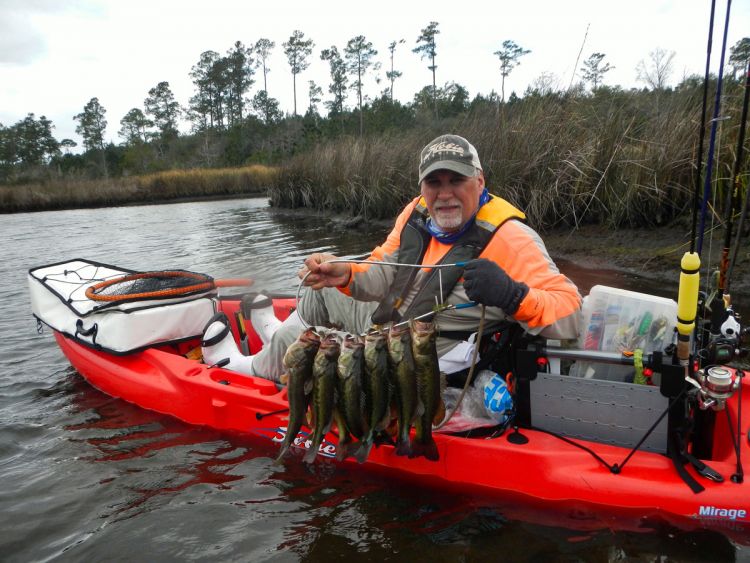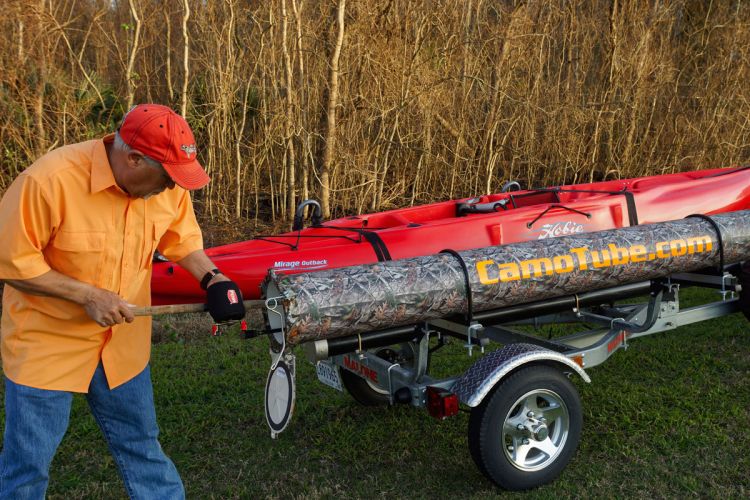
Ways to protect your kayak and fishing gear
One of the allures of kayak fishing is that the boats are lightweight and easy to transport. However, that also makes them susceptible to theft.
Whether at home or on the road for a fishing trip, there are several easy, inexpensive ways to keep folks honest.
Let’s be truthful, there really is no way to stop a determined thief from stealing your ’yak and/or gear. However, there are ways to deter and slow them down.
Adding an element of time to the act of theft that might lead to them being seen is one way. In reality, it’s more about keeping folks honest by not providing easy pickings.
A kayak sitting in the back of a truck can be stolen in a matter of seconds. A quick cut of the straps or rope and it can be silently swapped into another truck and gone in the blink of an eye.
Lock and cable
An inexpensive way to deter this type of theft is with a heavy-duty lock and cable. Almost all kayaks have scupper holes or thru-hull access points like a drive well to securely run the cable.
Secure the cable through the kayak and lock it to a solid point on the vehicle or nearby stationary object like a post or fence. While not foolproof, it takes heavy-duty tools to defeat this method, and all but the most determined thief will move on to easier targets.
There are also several brands of cables with built-in locks. They come in various lengths and have one end with just the plastic-coated cable so it is slim enough to go through the scupper holes in the kayak. The other end has the locking mechanism with either a keyed or combination lock.
The cable is passed through the kayak and through a secure mounting point, cinched down, and locked onto itself.
Cable lock
For those who do not want to mess with locks, keys or combinations, there is also a cable lock that has a small ball made onto one end. The cable is passed through the kayak and the ball is passed through a loop on the opposite end of the cable. The ball end is then simply placed inside the locked vehicle and is secured from removal by the door or trunk.
This is less secure than heavier cables, but it makes it a bit more difficult than just removing a strap and walking away with your kayak.
There are also specialty items that can be used separately or in conjunction with other locks or cables to add layers of theft deterrent.
Almost all kayakers use straps to secure their boats to their vehicles or trailers. There are several brands of nylon straps that are reinforced with stainless steel cable inside the strap. They won’t scratch the kayak or vehicle, and cannot be cut with a knife.
The straps are sold in pairs, and the buckle portion of the strap has a built-in keyed lock.
Gear protection
When it comes to theft, don’t overlook your gear. Rods and tackle left unsecured in the back of your vehicle or on a trailer can disappear in a flash.
There are many instances reported of folks stopping for gas or a bite to eat, only to discover that their gear has been subjected to a five-finger discount.
Common sense must prevail. If the situation allows, have one person stay with the vehicle while getting gas. If stopping to eat, try sitting at a spot that allows you to keep an eye on your stuff.
The best option is to lock your gear inside your vehicle if possible.
 Don’t overlook the obvious. There have also been reported thefts of gear at boat launches. In one instance, a guy came back from fishing and pulled his loaded kayak up the boat ramp and out of the way. In the time it took him to turn his back and walk to the parking lot to get his truck, someone had made off with a very expensive rod and reel combo.
Don’t overlook the obvious. There have also been reported thefts of gear at boat launches. In one instance, a guy came back from fishing and pulled his loaded kayak up the boat ramp and out of the way. In the time it took him to turn his back and walk to the parking lot to get his truck, someone had made off with a very expensive rod and reel combo.
Having your rods leashed to the kayak won’t prevent that, but it might slow them down.
If you transport using a trailer, consider adding a rod tube or box to provide a lockable storage area for long items like rods, paddles and stakeout poles.
There is nothing that can ruin the happiness of a great day kayak fishing like being the victim of a lowlife thief. You can’t prevent it in every case, but you can make it more difficult.


